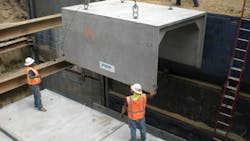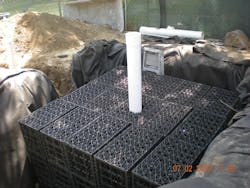From Chicago to Shanghai, cities around the world are turning to local landowners to realize critical water management and ecosystem goals that can mitigate ecological damage caused by urbanization. A decentralized green infrastructure approach offers certain practical advantages, but historically, municipalities have found it challenging to forecast the costs and environmental outcomes of such a strategy.
New economic research aims to help.
Looking at small-scale decentralized stormwater management best practices (BMPs) employed in Santa Monica, Calif., my colleagues and I explored the factors that impact a landowner’s choice of BMPs. Our findings offer important cost considerations and insights for city planners and water management decision-makers considering decentralized green infrastructure initiatives in their own communities.
The Centralized to Decentralized Spectrum
Effective stormwater management, like much of green infrastructure, requires municipalities to find their preferred position on the centralization to decentralization continuum.
Large, centralized stormwater management systems treat stormwater on a neighborhood or regional scale. Centralized systems are publicly managed, and policymakers select and implement BMPs they believe can cost-effectively meet stormwater management goals and deliver an optimal mix of ecosystem services. While all funding must come from the public purse in a centralized approach, the costs are clearly defined, and municipalities retain full control over the basket of environmental outcomes they expect to see.
Individual property level BMPs represent the most decentralized option. Examples of decentralized systems include green roofs, infiltration pits, permeable pavement and rainwater collection tanks. In a decentralized stormwater management system, cities mandate or incentivize landowners to implement BMPs on their property and allow for latitude regarding BMP technique and siting.
A city may regulate the types of BMPs a property owner can select, require performance criteria or offer an “opt out” option through a one-time in-lieu fee. In each of these scenarios, BMP choice lies with the landowner, meaning municipalities give up some control over the mix of ecosystem services that can be achieved. In this sense, the approach allows for added program flexibility and adaptability, yet no guarantee that the resulting cumulative benefits and environmental impacts will meet the city’s desired policy objectives.
Despite this uncertainty, municipalities are increasingly turning toward decentralization as part of a sustainable approach to water management. Many densely populated areas have become early adopters of low-impact development strategies that include small-scale BMPs to treat stormwater from single properties. For example, the city of Santa Monica has approved more than 2,000 such projects over the last two decades. From a land-use planning perspective, we can glean important economic insights by examining Santa Monica’s outcomes.
Examining the Factors That Impact Choice
Santa Monica requires rainwater BMPs on all new and redevelopment projects. The city gives landowners a choice between three broad types of ecosystem service provisions for rainwater management at the parcel or property level — harvesting and returning water for direct use, infiltration of water to groundwater and filtering out pollutants before returning water to the storm drain system. An in-lieu fee option is also available to add additional flexibility to the program.
We began with the simplest hypothesis — that property owners choose the least expensive BMP to meet their city-mandated mitigation requirement. Using 13 years’ worth of city records and county property-roll data, we applied statistical techniques to model the cost capacity curves — in other words, how the costs change with capacity — for direct use, infiltration, filtering and in-lieu payment options chosen for every new or redeveloped project larger than 500 square feet. Contrasting the capital costs of BMPs and BMP choice allowed us to examine whether non-financial factors such as overall site design are important components of landowners’ decisions.
Our modeling estimates offer predictions for policymakers regarding the BMPs that landowners are likely to select. A summary of our findings is outlined below.
- Landowners’ choices generally follow BMP capital costs. Landowners generally choose from among the least expensive options for their capacity.
- Other BMP costs to the landowner, such as land, aesthetics and the effect on the overall development plan, are also significant. Our analysis shows that average per-capacity costs vary by a factor of three across filtration and infiltration categories, which implies that landowners will at times choose a much higher-cost BMP in order to improve the overall development plan. This is not surprising, as BMP costs average less than 2 percent of overall project costs.
- The intensity of the overall (re)development project is likely to be a key factor in landowner choice. A bigger, more expensive project is expected to have aesthetic and lot-use demands that require a more complex and costly approach to stormwater management than a small-scale project. The greater the intensity of the overall redevelopment project, the more likely the landowner will choose either infiltration or in-lieu fees.
- When costs are close, infiltration is the preferred option. By far, the most popular rainwater BMP option in Santa Monica is infiltration. Across the data set, rain barrel BMPs were less costly than infiltration until about the 70th percentile of capacity, but they are only chosen for the smallest capacity requirement.
- Small capacity BMPs have high unit costs, but unit costs are similar across medium and high capacities. Both filtering and infiltration have initially high costs that fall steeply before flattening out. Direct use BMPs — in this case, rain barrel collection — generally have flat unit costs that are less expensive for all but the larger properties. However, in general, landowners prefer infiltration or filtering to direct use BMPs, so the combination of economies of scale and landowner choice results in initial high unit costs that fall by about 30 percent by the 25th percentile in capacity and then stay approximately constant.
- In-lieu fees are critical balancing mechanisms between decentralized and centralized approaches. We find that landowners rarely saved much over their BMP capital costs by paying the in-lieu fee. Instead, the density (higher floor-area-ratio) and the type of use (multi-family or commercial) are the significant drivers of in-lieu fee choice. In-lieu fees allow developers to fulfill their rainwater obligation by direct payment to the city rather than be forced to implement a BMP in dense, commercial areas.
Other Considerations for Policymakers
While focused on a single municipality, our research highlights considerations for policymakers developing similar decentralized strategies elsewhere in the U.S. and abroad.
It is worth mentioning that an area’s climate and development density should not be overlooked when building a stormwater management program that can provide ecosystem services while cost-effectively addressing water quality and water supply challenges. For example, some decentralized project BMPs, such as green roofs or artificial wetlands, have shown to be effective options in certain areas but are a poor fit with Santa Monica’s geography and building density. An area’s intensity of development may also affect the choice of mitigation compliance. For instance, more intensely developed sites will have a difficult time fitting BMPs into site design. Areas with higher-density development than in Santa Monica can expect to see increased demand for in-lieu fees, while less demand is likely in lower-density areas.
For cities exploring cost-effective green infrastructure policies, these findings provide a possible operating blueprint with the potential to help reliably meet environmental needs without draining the public coffer. WW
About the Author: W. Bowman Cutter is an environmental economist who focuses on water and urban environmental issues.





